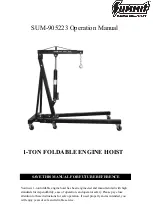
8.2
Inspection intervals
During commissioning or
after the
fi
rst 3 months
every year
Distance of the rope guard
x
x
Check vibration isolation
The thickness of the vibration isolation must be the
same on the right and left.
x
x
Checking the air gap of the brake
x
x
Visual inspection of the mounting screws on the hous-
ing, brakes and traction sheave.
The locking compound must be free of damage.
x
x
Check the traction sheave if worn out
x
Checking the inductive proximity switch
x
Relubricate bearing with SKF LGEV 2 - cartridge 420
ml LGEV2/0.4
x
Table 8-2
Note: All
fi
xing screws on the housing, brakes and traction sheave are marked with locking varnish.
That means a loosened screw is optically visible. If a screw does get turned, it must be tightened
using the prescribed tightening torque, the old locking varnish needs to be removed and marking has
to be made again.
8.2.1
Checking the air gap
Figure 8-2-1-01 - Air gap measurement position
Figure 8-2-1-02 - Air gap measurement
1. The air gap "A" must be checked three times around the circumference of all three brakes when
the brake is disconnected from the power supply (see arrows). The maximum value from the
measurements is taken as the assessment criterion.
2. If the maximum air gap is reached on a brake, the brake pad needs to be replaced.
ZIEHL-ABEGG SE recommends replacing the pads on all three brakes at the same time.
Maximum permissible air gap after wear: 1.8 mm!
Caution!
To prevent damage to the shock-absorber elements or interference from the springs, do
not insert the feeler gauge more than 10 mm into the air gap.
Original operating instructions
ZAtop
–
model series SM315.100A
Service and maintenance
A-TBA22_02-GB 2022/50 Index 002 Part.-No. 01013486-GB (EU-BD 1075)
30/76
















































